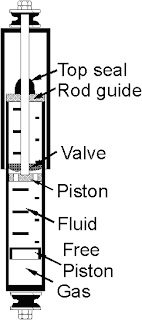 |
| An average MTB shock, yesterday. |
Spring & Damper
A basic shock absorber consists of two things, a spring and a damper. The spring is quite simple, a metal coil, or an air spring. The spring supports (or suspends) the weight on the bike (i.e. you). We won't consider springs very much here. Suffice to say that when you compress a spring, it extends again, and can oscillate. Oscillations are baaad, mmkay? A shock that did this would ride terribly. We need a thing to stop the oscillations - the damper. The damper is where the magic happens. Let's look inside...Oily
Dampers are much of a muchness (well, sort of). They all consist of a tube, within which a piston moves. The tube is fixed to one shock eye. The damper piston is connected via a shaft, to the other shock eye. Most of the entire tube is filled with oil. A small gas (usually nitrogen or air) chamber occupies one end of the tube.The damper piston has holes. This is important! These are small holes, which allow oil to flow from one side of the piston to the other. The size of these holes determines how "stiff" the shock feels when moving (which has nothing to do with the coil spring outside the damper). Small holes, stiff, large holes, not so stiff. A really basic damper will have holes that allow oil to go both ways. That allows for very basic control over the movement of the shock.
Did I leave the gas on?
Remember that gas chamber at the end? The gas chamber is there to give the oil space to expand into. And why does the oil expand? Two reasons - firstly, when temperature rises it expands a little, and secondly, and more importantly, when the shock compresses, the damper shaft takes up some extra space in the oil chamber. That displaces some oil, and the gas chamber gives that oil somewhere to go.Floater
So, take a simple looking shock, with a single tube damper. The tube is fixed to one shock eye. On the inside, gas is separated from the oil by an floating piston (IFP, internal floating piston). In the oil is a piston with holes in, connected to the other shock eye by a shaft.- As the whole shock compresses or extends, oil flows from one side of the main damper piston to the other, through small holes.
- As the shock compresses, oil pushes on the IFP and the volume of the gas chamber decreases.
- As the shock extends (or rebounds), the gas chamber volume increases again.
Shimmy to the Left
One side of each oil holes in our damper piston are usually covered with very thin pieces of metal called shims. The shims work just like one-way valves - only opening up when the main piston moves in a specific direction. If the shim is on the shaft side, it will flex away from the piston and allow oil through, only when the main damper piston is moving in (shock is compressing). If the shim is on the other side, it flexes only in the other direction, on rebound (extension).What that means is that the shock can behave differently in compression and rebound. The important bit here is the one-way behaviour. This splits the oil flow into different "circuits".
Shimmy to the Right
The usual setup in cheaper MTB dampers is to have a fixed compression circuit (holes & shims), and an adjustable rebound circuit. The rebound knob is often located remotely, right by a shock eye - and all it does is pinch off an oil pathway (which is connected to the hole that opens in the rebound direction).This allows you to tune the most important ride characteristic - rebound - which determines how slowly the damper releases the energy it absorbs from bumps.
Piggyback Ride
 |
| Manitou Swinger 4 & 6 Way Internals (copyright Manitou etc etc etc) |
So now, as the shock compresses, oil (displaced by the main damper piston's shaft) flows from the main damper body, through the oil pathway, and into the piggyback chamber. The oil pushes on the IFP in the piggyback, which reduces the gas chamber volume - exactly like the simple single tube shock.
Adjustment Bureau
So there are a few possible adjustments we can make on a damper:- Rebound damping (close down the oil circuit for slow rebound, open it up for fast rebound)
- Compression damping...
- ...often split on better dampers into high and low speed.
Rebound damping as needed to prevent the oscillations mentioned right at the start. Let the damper compress as quickly as needed when you go over bumps, and then slowly return to its normal place. That's "all" the shock has to do...
High speed compression damping affects big hits and rough terrain. Slow speed compression damping affects pedalling and, well, slowly changing terrain.
To get a good pedalling action on your bike (ie reduce the bobbing) you can increase low speed compression damping. That then makes it hard for the shock to move slowly. If the high speed compression damping is left open, as soon as you hit a drop or even just a small sharp bump (e.g. something like a kerb), the shock compresses quickly, and in the damper oil now moves through the high speed circuit - which we can leave open, making the shock sensitive to terrain.
More!?
Yeah, I know, I haven't described propedal or platform or spv shocks, or the cane creek double barrel, or...For further reading:
http://www.racetech.com/page/title/G3S%20Shock%20Types
http://www.krankin.co.nz/design%20dd.htm
 |
| Oh crikey, its the LuJin. |



Great explanation! Cheers
ReplyDelete